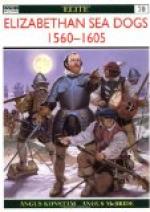The life of the sea-dogs, gentlemen-adventurers, and merchant-adventurers should be studied in Hakluyt’s collection of Principal Navigations, Voiages, Traffiques, and Discoveries; though many of his original authors were landsmen while a few were civilians as well. This Elizabethan Odyssey, the great prose epic of the English race, was first published in a single solemn folio the year after the Armada—1589. In the nineteenth century the Hakluyt Society reprinted and edited these Navigations and many similar works, though not without employing some editors who had no knowledge of the Navy or the sea. In 1893 E.J. Payne brought out a much handier edition of the Voyages of the Elizabethan Seamen to America which gives the very parts of Hakluyt we want for our present purpose, and gives them with a running accompaniment of pithy introductions and apposite footnotes. Nearly all historians are both landsmen and civilians whose sins of omission and commission are generally at their worst in naval and nautical affairs. But James Anthony Froude, whatever his other faults may be, did know something of life afloat, and his English Seamen in the Sixteenth Century, despite its ultra-Protestant tone, is well worth reading.
HAWKINS. The Hawkins Voyages, published by the Hakluyt Society, give the best collection of original accounts. They deal with three generations of this famous family and are prefaced by a good introduction. A Sea-Dog of Devon, by R.A.J. Walling (1907) is the best recent biography of Sir John Hawkins.
DRAKE. Politics, policy, trade, and colonization were all dependent on sea power; and just as the English Navy was by far the most important factor in solving the momentous New-World problems of that awakening age, so Drake was by far the most important factor in the English Navy. The Worlde Encompassed by Sir Francis Drake and Sir Francis Drake his Voyage, 1595, are two of the volumes edited by the Hakluyt Society. But these contemporary accounts of his famous fights and voyages do not bring out the supreme significance of his influence as an admiral, more especially in connection with the Spanish Armada. It must always be a matter of keen, though unavailing, regret that Admiral Mahan, the great American expositor of sea power, began with the seventeenth, not the sixteenth, century. But what Mahan left undone was afterwards done to admiration by Julian Corbett, Lecturer in History to the (British) Naval War College, whose Drake and the Tudor Navy (1912) is absolutely indispensable to any one who wishes to understand how England won her footing in America despite all that Spain could do to stop her. Corbett’s Drake (1890) in the ‘English Men of Action’ series is an excellent epitome. But the larger book is very much the better. Many illuminative documents on The Defeat of the Spanish Armada were edited in 1894 by Corbett’s predecessor, Sir John Laughton. The only other work that need be consulted is the first volume of The Royal Navy: a History, edited by Sir William Laird Clowes (1897). This is not so good an authority as Corbett; but it contains many details which help to round the story out, besides a wealth of illustration.




